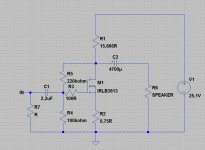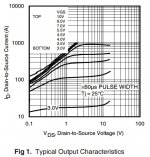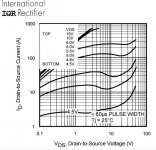IRLB3813 and IRFP7430 Triode-curve
After drooling over unobtainable (for me) Pass SIT jfets and expensive hard to get Sony and Yamaha SITs I looked around at some normal switching fets from IR for an extended range of voltages with typical Triode character.
The IR part IRLB3813 has an distinct Triode curve starting at 5 volts and increases to 20 volts or so.
They are cheap and easy to get, and the 30 volt rating is plenty enough for my 25 volt power supply. I bought some of them and replaced my old IRFP150 in an no global feedback power-resistor drain-loaded Zen amp i am experimenting with at the moment. The result is quite astonishing....
At 10 volts D-S over the fet it has a lot of distortion and sounds quite terrible.
With 8 volts D-S and a 0,75 ohm source-resistor it sounds very very nice. Very present and alive. It is a whole new amp compared to the laid back and comparably mellow sound of the IRFP150.
Even though it has a Ciss of 8 nF and needs a low impedance output preamp it does not sound harsh. There is no lack in highs. It sounds like a very powerful 20 watt amp, and i am quite astonished by the amount of power it can produce. The amp should be able to output 1,5 watts, but it sounds like it has 20 watts or so. I know it does not. Today my kids told me they could hear the music through the walls of our house. They were standing next to the running car outside and was worried it would irritate our neighbors.
After drooling over unobtainable (for me) Pass SIT jfets and expensive hard to get Sony and Yamaha SITs I looked around at some normal switching fets from IR for an extended range of voltages with typical Triode character.
The IR part IRLB3813 has an distinct Triode curve starting at 5 volts and increases to 20 volts or so.
They are cheap and easy to get, and the 30 volt rating is plenty enough for my 25 volt power supply. I bought some of them and replaced my old IRFP150 in an no global feedback power-resistor drain-loaded Zen amp i am experimenting with at the moment. The result is quite astonishing....
At 10 volts D-S over the fet it has a lot of distortion and sounds quite terrible.
With 8 volts D-S and a 0,75 ohm source-resistor it sounds very very nice. Very present and alive. It is a whole new amp compared to the laid back and comparably mellow sound of the IRFP150.
Even though it has a Ciss of 8 nF and needs a low impedance output preamp it does not sound harsh. There is no lack in highs. It sounds like a very powerful 20 watt amp, and i am quite astonished by the amount of power it can produce. The amp should be able to output 1,5 watts, but it sounds like it has 20 watts or so. I know it does not. Today my kids told me they could hear the music through the walls of our house. They were standing next to the running car outside and was worried it would irritate our neighbors.
Last edited:
Hi, coutld you reproduce your findings diagram ?
I was watching the data sheet and the curves are weird (IMHO)
Best Regards
I was watching the data sheet and the curves are weird (IMHO)
Best Regards
https://www1.elfa.se/data1/wwwroot/assets/datasheets/irlb3813pbf_eng_tds.pdf
Yes, the curve is a bit weird, but it does sound wonderful with the right voltage across it.
I will post the chematic once i find it on my other harddrive.
regards,
Johannes
Yes, the curve is a bit weird, but it does sound wonderful with the right voltage across it.
I will post the chematic once i find it on my other harddrive.
regards,
Johannes

This is the circuit as it is built.
R4 is a multi-turn potentiometer.
R7 is 100 kohm.
cascoding for other purposes ?
Yes, this is one of the reasons i wanted to buy this fet. It has a lot of transconductance since it is low voltage high current device.
It can take a lot of power. Very low thermal resistance for a TO-220 case. About the same as an IRFP150.
regards,
Johannes
But this is an enhancement mosfet?
Thanks for share with the rest of people.
I am encouraging day after a new day, but life is short.
I want to finish a lot of very pretentious projects a Ongaku clone, the csx1, the lamp with SIC, the A75, the OB, the audioprocessor to multiamp. The phono preamplifier. The CD player (shigaclone and Philips CD Pro 2) The new Soekris DAC.
Best Regards for you
Thanks for share with the rest of people.
I am encouraging day after a new day, but life is short.
I want to finish a lot of very pretentious projects a Ongaku clone, the csx1, the lamp with SIC, the A75, the OB, the audioprocessor to multiamp. The phono preamplifier. The CD player (shigaclone and Philips CD Pro 2) The new Soekris DAC.
Best Regards for you
Last edited:
I'm in the process of building my first ever amplifier using this schematic and transistor, beeing a total newcommer to this side of the speakerterminals I found the simplicity of this amplifier, or perhaps rather this type of amplifier, to be easy enough for me to take on, very siutable for a first time out P2P design.
The resons I took the step into this world can mainly be contributed to Mr. Pass and his easy to understand and often entertaing explanantions, both in movies and in written publications, but that alone would not have tipped the scale, the blame for that resides heavliy on the shoulders of this thread's owner, Circlomanen, who greatly added to my understaning and enthuiasm to get started.
The components are on their way, and no matter the outcome (no doubt it will be enjoyable although with a hint of fire and screaming seeing as it's me wielding the tools) I have so far and will once finished have gained alot of new knowledge, thanks to Pass and Circlomanen.
The resons I took the step into this world can mainly be contributed to Mr. Pass and his easy to understand and often entertaing explanantions, both in movies and in written publications, but that alone would not have tipped the scale, the blame for that resides heavliy on the shoulders of this thread's owner, Circlomanen, who greatly added to my understaning and enthuiasm to get started.
The components are on their way, and no matter the outcome (no doubt it will be enjoyable although with a hint of fire and screaming seeing as it's me wielding the tools) I have so far and will once finished have gained alot of new knowledge, thanks to Pass and Circlomanen.
what a strange MOSFET....transconductance: min. 140 Siemens 😱
continuous drain current 260 ampere for a TO-220.... 😕
continuous drain current 260 ampere for a TO-220.... 😕
It is a bit strange isn’t it, but I like strange and testing something a bit different, I believe the triode characteristics is likely to become more apparent when you lower the Amperes (look at the vertical scale) and extrapolate the trend it exhibits around 8-10V.
Attachments
Would you get better bass response by doubling in size the input and output caps, like in the Zen amp series?
Is it 1.6A across the drain resistor? Is it 40-50w?
Is it 1.6A across the drain resistor? Is it 40-50w?
Last edited:
This is the state of the CAD "virtual build" at the moment, it is by no means not finished just quite yet, but it is a good exercise in routing and component packaging, all components below are dimensioned according to their respective specs.
The PS is 200VA 9+9V and the PS Cap's are 6x 15.000uF.

The PS is 200VA 9+9V and the PS Cap's are 6x 15.000uF.

With respect for the fact that this is niether the topic of the thread or a Pass amp (although it is heavily inspired by Mr. Pass work according to the designer Circlomanen) I think it would be more apropriate to perhaps start another thread about this build in a more apropriate forum section, it was only ment as an example of what I'm plannig to do with this perticular transistor.
Last edited:
- Home
- Amplifiers
- Pass Labs
- IRLB3813 Triode-curve

